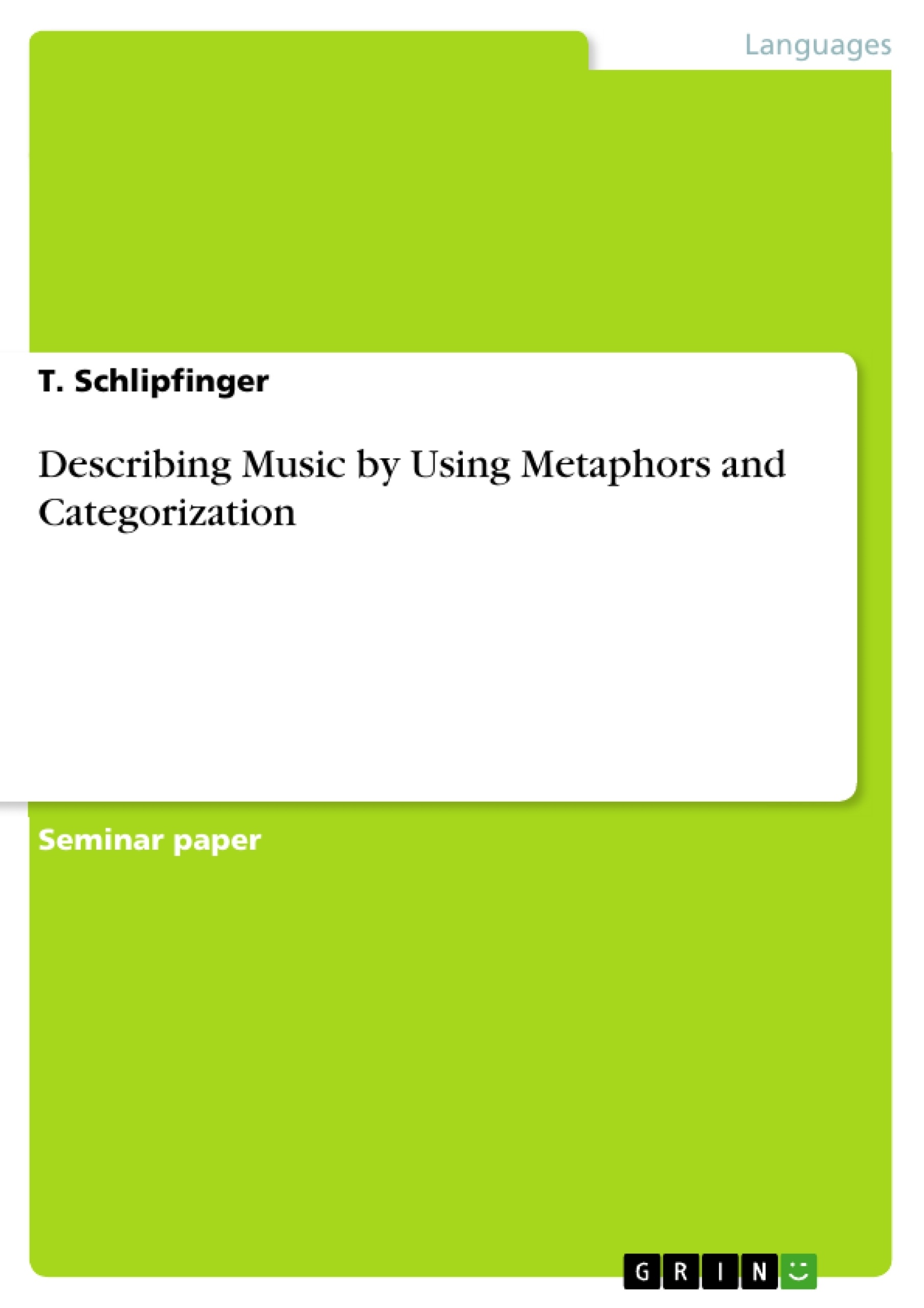In the following paper, I am going to talk about how music is described out of a linguistic point of view. I am going to show how and which metaphors are used and how categorization works. Right at the beginning I have to mention that I am more into modern music, in particu-lar the Rock genre, therefore the majority of examples in this paper will come from this one. However, when reading it, one should always bare in mind that all the theories mentioned below can be applied to any kind of music.
Table of Contents
- Introduction
- Metaphors
- Usage
- Gaut's Two Level Theory
- Two Different Ways of Talking about Music
- Synaesthetic Metaphors
- Categorization
- The Basic Level
- Prototypes
- Radial Categories
- The Reasons for and the Effects of Categorization
- Conclusion
Objectives and Key Themes
This paper examines how music is described from a linguistic perspective, focusing on the use of metaphors and the process of categorization in defining musical genres. The study explores existing linguistic theories and applies them to the analysis of musical description, demonstrating the universality of these theories across different domains.
- The use of metaphors in describing music
- The role of synesthesia in musical metaphors
- Categorization of music into genres
- Application of Lakoff's theory of categorization to music
- The universality of linguistic theories in analyzing artistic expression
Chapter Summaries
Introduction: This introductory section lays the groundwork for the paper by outlining its objectives. The author states their focus on modern rock music for examples but emphasizes the broader applicability of the discussed theories to all music genres. The paper is structured into two main parts: one focusing on metaphors in musical description and the other on the categorization of music into genres. It highlights the relative scarcity of research on this specific topic and justifies the adaptation of existing linguistic theories to this area of study.
Metaphors: This chapter delves into the nature and function of metaphors when describing music. It begins by illustrating how metaphors illuminate aspects of music that are difficult to describe literally, drawing upon the work of various scholars. The chapter then explores the common usage of metaphors in music description, emphasizing that while seemingly straightforward, many literal-sounding descriptions actually originate from metaphorical roots. A significant portion is dedicated to the prevalent use of synesthetic metaphors, where terms from other senses (sight, touch, taste, smell) are applied to auditory experiences. This section uses Joseph Williams's research on the historical evolution of synesthetic adjectives to explain the prevalence of this metaphorical approach.
Categorization: This section shifts focus from metaphors to the process of categorizing music, particularly into genres. It draws heavily upon Lakoff's theory of categorization, testing its universality by applying it to the field of music genres. The chapter explores concepts like prototypes and basic levels within the framework of Lakoff's model, offering an alternative to the "classical theory" of categorization. The discussion includes the concept of radial categories as a way of understanding the complex and often overlapping nature of musical genres.
Keywords
Cognitive semantics, metaphor, categorization, music description, musical genres, synesthesia, Lakoff's theory, prototype theory, radial categories, linguistic analysis of art.
Frequently Asked Questions: A Linguistic Analysis of Music Description
What is the main topic of this paper?
This paper examines how music is described linguistically, focusing on the use of metaphors and categorization in defining musical genres. It applies existing linguistic theories to analyze musical descriptions, demonstrating their universality across different domains.
What are the key themes explored in the paper?
The paper explores the use of metaphors in describing music, the role of synesthesia in musical metaphors, the categorization of music into genres, the application of Lakoff's theory of categorization to music, and the universality of linguistic theories in analyzing artistic expression.
What linguistic theories are discussed in the paper?
The paper draws upon several linguistic theories, prominently featuring Lakoff's theory of categorization. It also incorporates discussions of prototype theory and the concept of radial categories to explain how musical genres are understood and classified. The role of metaphorical language, including synesthetic metaphors (combining sensory experiences), is extensively analyzed, referencing works by scholars like Joseph Williams.
How is the paper structured?
The paper is structured into an introduction, a chapter on metaphors in musical description, a chapter on the categorization of music, and a conclusion. The introduction outlines the objectives and scope of the study. The metaphor chapter examines the usage, function and types of metaphors in describing music, particularly synesthetic metaphors. The categorization chapter explores how music is grouped into genres, drawing on Lakoff's model and addressing concepts like basic levels, prototypes, and radial categories.
What specific examples of music are used in the paper?
While the author uses modern rock music as examples throughout the text for illustrative purposes, the theories presented aim to be applicable to all genres of music.
What is the significance of the research?
The research contributes to a relatively under-researched area by applying established linguistic theories to the analysis of musical description. It highlights the universality of these theories and demonstrates how they can illuminate the complexities of understanding and expressing musical experiences.
What are the key terms/keywords related to this study?
Key terms include cognitive semantics, metaphor, categorization, music description, musical genres, synesthesia, Lakoff's theory, prototype theory, radial categories, and linguistic analysis of art.
What is the conclusion of the paper?
The conclusion summarizes the findings of the study, reinforcing the applicability of the discussed linguistic theories to the analysis of musical description and emphasizing the universality of cognitive processes in understanding and expressing artistic expression. (The specific details of the conclusion are not explicitly provided in the chapter summaries).
- Quote paper
- T. Schlipfinger (Author), 2010, Describing Music by Using Metaphors and Categorization, Munich, GRIN Verlag, https://www.grin.com/document/193964




